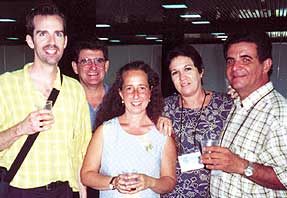A look at la medicina veterinaria Cubana
|
The island republic of Cuba has more than 6,800 veterinarians, consisting of an equal ratio of male to female (although women veterinarians are on the rise). Most veterinarians in Cuba are not in private practice. In the past year, Dr. Naomi Bierman and Dr. Eric Hartmann traveled twice to Cuba and met with veterinarians from several provinces. The following is a firsthand account of their experiences and some knowledge they gained about veterinary medicine in Cuba. When we first visited Cuba in December 1999 we were greeted warmly by Dr. Adela Encinosa Liñero (president) and Dr. Fermin Palazuelos (executive director) of the Cuban Veterinary Scientific Council. They generously offered their time and energy, and facilitated many of our tours and contacts. The council is a nongovernmental organization with an aim to foster an interchange of information in the scientific, technologic, and social spheres. The objective of the association, numbering over 5,000 members, is to unite professionals in the veterinary field, within Cuba and abroad, in a cooperative effort to increase livestock production, improve the quality of animal products for human consumption, assist in environmental protection, and safeguard human and animal welfare. The council has 15 professional societies in areas such as tropical disaster medicine, pathology, parasitology, and surgical and clinical medicine. The Cuban Veterinary Scientific Council is the only organization designed for veterinarians, but many are involved with other groups, such as the Cuban Association for the Protection of Animals and Plants, the Cuban Association of Animal Production, Sociedad Cubana de Epidemiologia (Cuban society of epidemiology), and the Cuban Association of Agriculture and Forestry.
Four veterinary schools exist in Cuba, as well as several collaborating technical and research institutes. An important component of the curriculum of the current generation of veterinary students is an interdisciplinary approach to the development of sustainable forms of agriculture. Degrees conferred by all the universities in Cuba are valid for practice anywhere within the country. Further examinations are not required after graduation, but Cuba does have a national system of continuing education to maintain practice standards. Although many of Cuba's limited veterinary resources are devoted to food animal production, companion animals (especially dogs) are held in high regard. Their importance from a psychosocial perspective is not overlooked, especially in a country where the accumulation of material possessions tends to be de-emphasized. We toured the large animal clinic that was formerly associated with a veterinary school that has since been moved outside of Havana. Although the Cubans' human health care delivery system guarantees free care to all, Cuban veterinarians have limited access to the basic medicines and equipment to which we are accustomed. The surgical suite in the open-air clinic had a stainless-steel table, a light, and little else. Surgical equipment is in short supply, often creating the need for improvisation. During our second trip, in June, five veterinarians from the United States participated in the Fifth National Congress of Veterinary Medicine in Havana. The conference opened with a speech by Dr. Primo Arambulo III, coordinator of the Pan American Health Organization's Program of Veterinary Public Health, which addressed challenges for our profession in the new millennium, such as environmental issues, food safety, food production, and zoonotic disease. Alternative medicine has been increasingly integrated into the Cuban health care system. In 1991 the Ministry of Public Health issued a directive to doctors and dentists to use herbal medicines whenever possible. Acupuncture is now taught in the medical and veterinary schools, and many Cuban health care professionals use herbal medicine to varying degrees in their practices. A shortage of anesthetics and analgesics has led to the popularity of acupuncture for pain relief and as an alternative to anesthesia in minor surgical procedures. One example we observed was a project in which Drs. Vidal, Pereira, and Sotolongo, University of Cienfuegos had gut implants and moxa applied to acupuncture points as an alternative to administration of chloramphenicol for treatment of diarrhea in pigs. The value of this type of study lies not only in increasing the veterinary knowledge base, but also as a more economic alternative for impoverished and developing areas. At the request of the Cuban veterinarians, the International Veterinary Acupuncture Society will offer a basic course in veterinary acupuncture in Havana in 2001. On several occasions, we shared thoughts, stories, and songs (as well as deliciously sweetened coffee and rum) with Cuban veterinarians who were eager to learn about veterinary medicine in the United States. Given the limited availability of computers, access to the Internet can be difficult and slow. And, although the average veterinary salary of 20 US dollars a month may be sufficient to cover the subsidized costs of food, housing, education, and health care for a Cuban family, this extremely low income severely restricts participation in international events. A lack of funds for membership dues in veterinary associations, subscription fees for scientific journals, and participation in overseas conferences has made it difficult for Cuban veterinarians to exchange ideas and technical information with colleagues abroad. The Cuban veterinarians we visited issued an open invitation for other organizations and individuals to become involved in projects with them. In the words of Dr. Jesus Moreño Lazo, president of the veterinary association in Piñar del Rio, the Cuban veterinarians would like to "build a bridge of friendship and collaboration which eliminates existing boundaries [with their American colleagues]." | ||
